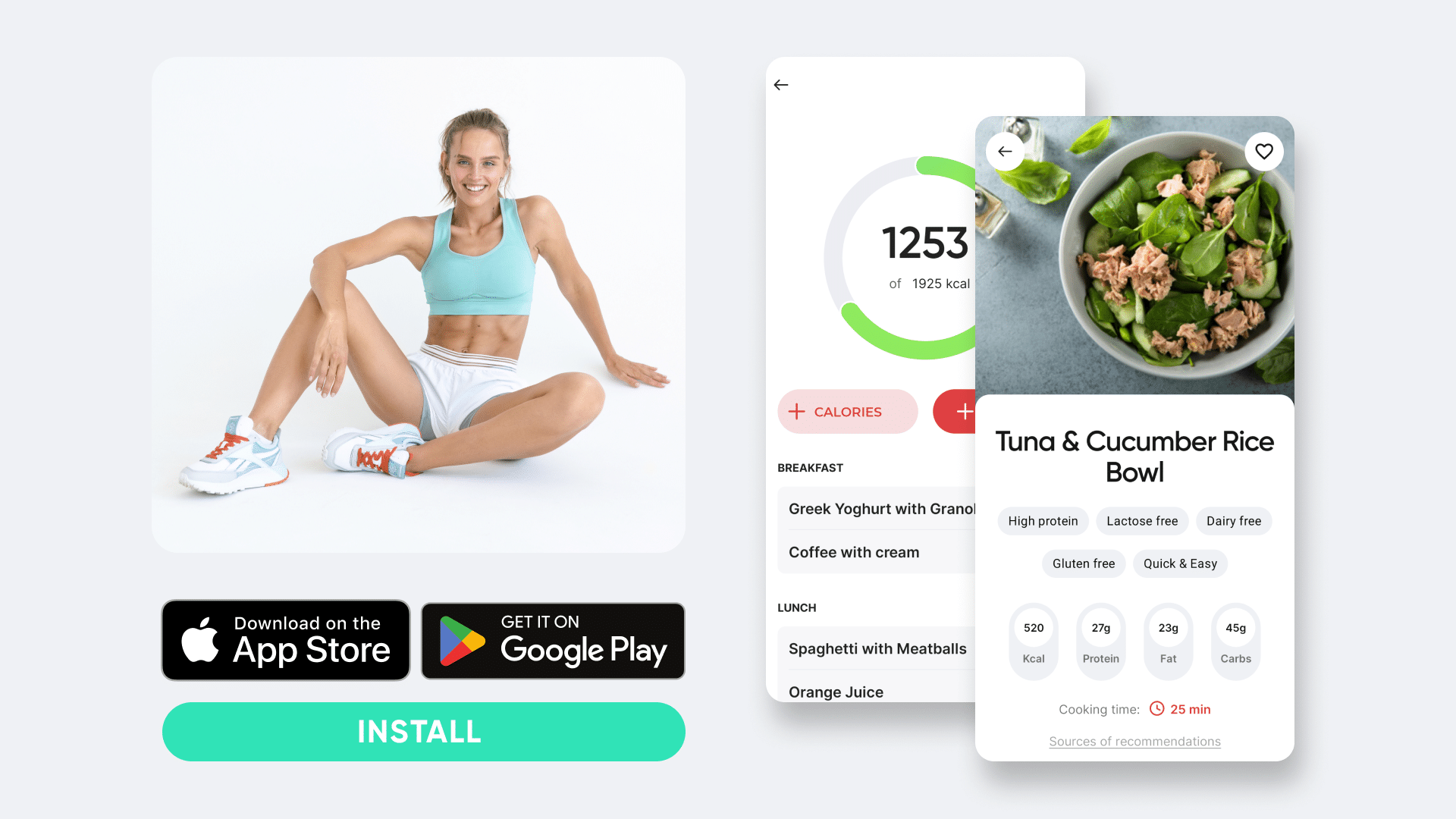If you were to take your rent out from your monthly budget, you may find that food is the second most expensive thing there – a fact that rings true for many families or even people who live alone. One way to reduce how much money you spend on food is by making a weekly meal plan and sticking to it.
In this article, we’re going to show you how to make a 2-week meal plan on a budget, how to eat cheaply and deliciously, and give you a sample of budget-friendly meals that will not only be delicious, but also great for your savings.
How to Shop for a 2-Week Meal Plan on a Budget
When it comes to meal planning or food prepping, most people generally make weekly plans with grocery store runs and meal prepping days on the weekend. While this is a good plan, if you’re a busy mom or a student, this weekly routine can get very old.
Opting to plan for food for 2 weeks can save you time and buying in bulk could save you money and help you save better. But how exactly do you do this? How do you effectively shop for a 2-week meal plan that’s both budget-friendly and avoids food waste?
Here are some tips to help.
1. Make a Menu
Before you head to the grocery store, take a few minutes to sit down and brainstorm what you want to eat for the next week, 2 weeks, or even the next month. Having a menu may seem a little old-fashioned, but it helps give you a good idea what should be on your grocery list.
It also gives you time to go through your fridge and pantry to make sure you’re truly out of the ingredients you need. This helps ensure that you don’t buy any extras you don’t need, thereby helping prevent food and ingredient waste.
2. Always Carry a Grocery List
This ties in with the point above. Having a grocery list at hand is basically like having a shopping guide that helps you buy what you truly need, which prevents impulse buys, unnecessary spending, and helps you stick to the budget. Remember this only works if you stick to the list!
3. Always Store Your Groceries Correctly
Not storing your food correctly can lead to groceries going bad faster, which will send you back to the store to get more food and ruin your budget.
Reducing food waste is good for your pockets and the environment. According to a study published in the Frontiers in Sustainable Food Systems journal, researchers assert that storing food properly helps enhance food security and food safety while reducing food expenditure and food wastage (6).
According to the Food and Agriculture Organization of the United Nations, reducing food waste can help reduce the yearly 14% global food loss while placing less strain on our natural resources and reducing environmental damage (2).
4. Buy Uglier Fruits and Vegetables
Often when we go to the supermarkets or grocery stores, we tend to reach for the shiny and perfect foods. The tomatoes and apples must be perfectly round and shiny, the cucumbers straight or just slightly curved, the bananas spot-free, and the vegetables should have fresh-looking leaves.
While there’s nothing wrong in wanting your groceries to be as aesthetic and pretty as possible, opting for blemish-free foods could be hurting your pockets. According to several reputable publications, uglier foods are actually sold at a cheaper price than their perfect, unblemished, brightly colored counterparts by as much as 50% (16, 1, 17). There are specialty services and programs that sell ugly or blemished produce at cheaper prices – some will even deliver it to you.
What started as a way to help prevent food waste – as foods that are considered ugly are often thrown out – could help save you some money in the long term. And just because the fruits and vegetables are oddly shaped or bruised doesn’t mean they’re bad – they taste just the same as their pretty counterparts (2).
In addition, naturally-grown fruits and vegetables aren’t always perfect and that’s the beauty of nature. Take a trip to your nearest farm and see for yourself!
Yanking yourself back in shape has never been so easy with our game-changing fitness app! Start transforming your life with BetterMe !
5. Cook At Home
If you don’t know how to cook, learn. The amount you spend at a restaurant for one meal could easily be used at a grocery store to get you the ingredients for two or even three budget-friendly home-cooked meals. Cooking at home also allows you to carry food to the office or workplace – this prevents you from buying food/snacks, which helps you save some money.
6. Cook in Bigger Portions
If you’re trying to make a 2-week meal plan for one person, you may be tempted to try and make smaller portions as you have no one to share them with. Instead of making one serving per meal, we suggest you increase your portions and make two, three or even more servings.
This gives you leftovers that can be refrigerated or frozen and eaten for later lunches or dinners. It also saves on gas/electricity and can prevent food waste as the ingredients don’t go bad waiting for you to make them. Just remember to store the cooked food properly so that it doesn’t go bad.
7. Buy Generic Brands
Brand loyalty and budget don’t belong in the same sentence and chances are that you’re paying a higher price for the name and not the food product.
8. Always Be on the Lookout for Sales
Foods are obviously much cheaper when they’re on sale and sales give you a chance to stock up on your staples at a lower price, particularly if they’re things that can be frozen or stored for an extended time. If you can, swap out an ingredient or two on your grocery list for something else that’s currently in the sale. Remember that you also always get the best prices on fruits and vegetables if you buy those that are in season at the time.
9. Buy Frozen/Canned Produce
One thing you must understand is that contrary to popular belief, frozen fruits and vegetables aren’t always cheaper than their fresh counterparts. According to the USDA, the price is largely determined by the type of fruit and vegetable (10).
However, if you’re thinking about keeping some of these foods in the long term, frozen foods have longer shelf lives and could be cheaper when factors such as waste are taken into consideration.
If you’re worried about the nutritional quality of frozen foods, research has shown that frozen and fresh food have relatively similar nutritional contents. Fresh foods also tend to lose some of their nutrients over time when they’re stored in the fridge, which makes frozen foods possibly better nutritionally (14).
Canned foods are also generally cheaper than fresh foods and have a longer shelf life, so they make the perfect ingredients to get on a 2-week meal plan on a budget.
10. Eat Less Meat
Meat, especially beef, can be quite expensive in terms of which cuts you get. Replace more expensive cuts with cheaper ones, buy chicken instead of beef, or better yet, replace meat with plant protein from tofu, beans, or eggs.
How Do I Plan for Food for 2 Weeks?
Now your shopping is done, the next step is to start meal planning for the next 14 days. Meal planning is one of the most convenient things that anyone on a budget or during a time crunch can do for themselves. Doing this on a budget also ensures you can track where your money goes in terms of food consumption and buying.
Here are some simple tips on how to plan for budget-friendly meals:
1. Make a Menu and Save Recipes
If you didn’t do this before, now’s the time to do it. Work around the grains, fruits, and vegetables you bought and decide what you want to eat for the next two weeks.
If you’re not very confident in your cooking skills, look up some recipes to match these meal ideas. These recipes will help you make some great food that you’ll look forward to eating and you can cut down on the time you spend cooking, which is especially good for those who aren’t too familiar with the kitchen or certain ingredients.
2. Try Meatless Mondays
Meat lovers know that this ingredient is delicious but that it can put quite a dent in your pocket. To prevent this and save some money, ensure you have at least one day a week where you don’t consume meat. A popular day to do this is Monday, but you can choose any day of the week you want to.
3. Make Juices and Smoothies
If you end up buying some blemished or overripe seasonal fruits and vegetables to save some cash, you may need to use them quickly before they go bad. Fruit and vegetables make great ingredients for smoothies that can be consumed as natural salt-free snacks or meal replacements.
Natural juices and smoothies generally last between 24 hours and 5 days when stored in the fridge, so make sure to keep them in there in an airtight container. To get the most out of your fruit and vegetable drinks, we recommend blending rather than juicing as the former doesn’t get rid of the important fiber in these drinks.
4. Always Eat Your Leftovers
As mentioned above, wasting food is bad for the environment and your pockets. Always make sure you eat all your leftovers. You can always have them as they are or look up recipes on how to repurpose said leftovers, thereby making a new meal out of cooked foods you already had.
5. Always Use What You Have First
Before you head to the store to buy more things, take a look in your freezer, pantry, and fridge and make sure to make meals with what you have on hand first, particularly if it’s nearing its expiration date.
Read more: A Beginner Intermittent Fasting Meal Plan To Fit Your IF Journey
What Is the Cheapest, Healthiest Food You Can Eat?
The cheapest and healthiest foods are always those that are in season, especially when it comes to fruits and vegetables. This is why shopping seasonally is always encouraged.
Other foods you should look out for when on a budget include:
- Beans and lentils, especially dried
- Rice – choose brown rice for more fiber
- Canned seafood
- Low-fat dairy products
- Affordable frozen vegetables and fruit
- Oatmeal and other whole grains
- Pasta – opt for the whole-grain version for more fiber
- Canned fruits
Once again, always look out for sales at your local store. Sometimes the usually expensive stuff can have 50% off, which can help broaden your menu and give you something fun to eat while remaining budget-conscious.
Sample Meals for a 2-Week Meal Plan on a Budget
Listed below are examples of some cheap easy meals on a budget you can easily make using the ingredients from the above grocery list.
2-Week Meal Plan on a Budget Breakfast Options
-
Peanut Butter Sandwich
Ingredients: 2 slices of bread, 2 tbsp peanut butter, 1/2 medium-sized banana, 1/2 tsp honey, a sprinkle of cinnamon
Calories: 434. Fats: 17 g. Protein: 16 g. Carbs: 60 g.
-
Scrambled Eggs On Toast
Ingredients: 2 slices bread, 1/2 tbsp butter, 2 medium-sized eggs, 1/3 cup feta cheese crumbles
Calories: 545. Fats: 27 g. Protein: 35 g. Carbs: 42 g.
-
Oat Pancakes
Ingredients: 1 cup oats, 1 cup milk, 2 large eggs, 1 tbsp unsalted butter, 1 tbsp sugar, 2/3 cup all-purpose flour, 2 tsp baking powder, 1/4 tsp salt, 1/4 tsp ground cinnamon
This recipe makes 4 servings
Calories for one serving: 262. Fats: 8.8 g. Protein: 10 g. Carbs: 36.5 g.
Get the recipe from The Kitchn (8).
-
Chicken Sandwich
Ingredients – 1 1/2 cups chopped cooked chicken, 1/2 cup chopped celery stalk, 1/3 cup finely chopped onion, 1/2 cup mayonnaise, 1/4 tsp salt, 1/4 tsp pepper, 8 slices of bread
This recipe makes 4 sandwiches
Calories for one sandwich: 430. Fats: 27 g. Protein: 19 g. Carbs: 27 g.
Get the recipe from Betty Crocker (4).
Budget Lunch Ideas
If you’re not working from home, we suggest that you get a lunch box to help carry your lunch to work.
-
Chicken Pasta Salad
Ingredients: 2 chicken breasts, 3-4 tbsp olive oil, 2 minced garlic cloves, 170 g dry pasta, 1 1/2 tbsp chopped thyme, 1 tbsp oregano, 1 cup cherry tomato halves, 1/2 yellow bell pepper, 1/4 cup green olives, 1/2 medium-sized red onion, 2 tbsp Parmesan cheese, 1 1/2 packed cups roughly chopped arugula, salt and black pepper to taste
Dressing: 2 tbsp extra virgin olive oil, 1 tbsp white wine vinegar, 1/2 tsp honey, 1/2 garlic clove minced, red pepper flakes, salt and freshly ground black pepper to taste
This makes 3 servings
Calories for one serving: 468. Fats: 20 g. Protein: 27 g. Carbs: 45 g.
Get the recipe from Healthy Fitness Meals (3).
If you wish to cinch your waist, tone up your bat wings, blast away the muffin top – our fitness app was created to cater to all your needs! BetterMe won’t give excess weight a chance!
-
Minestrone Soup
Ingredients: 4 tbsp extra-virgin olive oil, 1 medium-sized yellow onion, 2 medium-sized carrots, 2 medium-sized ribs celery, 1/4 cup tomato paste, 2 cups chopped potatoes, 4 minced garlic cloves, 1/2 tsp dried oregano, 1/2 tsp dried thyme, 1 large can diced tomatoes (with their liquid), 4 cups vegetable broth, 2 cups water, 1 tsp fine sea salt, 2 bay leaves, red pepper flakes, ground black pepper, 1 cup small shell pasta, 1 can beans, 2 cups baby spinach, 2 tsp lemon juice,
This recipe makes 6 servings
Calories for one serving: 298. Fats: 10.5 g. Protein: 9.8 g. Carbs: 45.6 g.
Get the recipe from Cookie and Kate (5).
-
Tex-Mex Style Migas
Ingredients – 1 tbsp olive oil, 1/2 small onion, 1 seeded and minced jalapeño pepper, salt and pepper to taste, 2 corn tortillas, 4 large eggs, 1/8 cup salsa, 1/2 cup shredded Cheddar cheese
This makes 2 servings
Calories for one serving: 407. Fats: 27.1 g. Protein: 23.1 g. Carbs: 18.4 g.
Get the recipe from The Kitchen (13).
-
Egg Fried Rice
Ingredients: 4 large eggs, 3 tbsp vegetable oil, 1 cup diced onion, 2 cups diced mixed vegetables, 1/2 cup sliced scallions, pinch of salt, 4 cups cooked rice, 2 1/2 tbsp soy sauce, 1/2 teaspoon five-spice powder, 1 tsp toasted sesame oil
Calories for one serving: 425. Fats: 16.7 g. Protein: 13.4 g. Carbs: 55.6 g.
Get the recipe from Health Nibbles (15).
Dinner Options for a 2-week Dinner Meal Plan on a Budget
-
Low Carb Lasagna
Ingredients: 1 large eggplant, 1 large zucchini, 12 ounces sausage, 1/2 onion, 2 minced garlic, 1 can crushed tomatoes, 1/4 cup dry red wine, 1 tsp dried basil, 1 tsp dried oregano, 1 cup ricotta cheese, 1 large egg, 1/4 teaspoon ground pepper, 1 cup mozzarella, fresh basil
This makes 8 servings
Calories for one serving: 279. Fats: 16 g. Protein: 17 g. Carbs: 19 g.
Get the recipe from Eating Well (11).
-
Chicken Potato Bake
Ingredients: 60 g unsalted butter, 6 skinless boneless chicken thighs, 80 g smoked pancetta, 2 large onions, 40 g plain flour, 500 ml chicken stock, tbsp finely chopped tarragon, 3 tbsp wholegrain mustard, 4 tbsp double cream, 900 g mashed potato, drizzle of olive oil
This makes 2 servings
Calories for one serving: 564. Fats: 35 g. Protein: 25 g. Carbs: 35 g.
Get the recipe from BBC Good Food (7).
-
Penne With Tomatoes & White Beans
Ingredients: 8 ounces uncooked penne pasta, 2 tbsp olive oil, 1 minced garlic clove, 2 cans (14-1/2 ounces each) Italian diced tomatoes, 15-ounce can cannellini beans, 10 ounces fresh spinach, 1/4 cup sliced ripe olives, 1/2 tsp salt, 1/4 tsp pepper, 1/2 cup grated Parmesan cheese
This makes 4 servings
Calories for one serving: 491. Fats: 13 g. Protein: 19 g. Carbs: 77 g.
Get the recipe from Taste of Home (12).
How to Make a 2-Week Keto on a Budget Meal Plan
The ketogenic diet plan distinguishes itself from all the rest by demanding that its followers consume incredibly high amounts of fat and severely limit the amount of carbs they eat in a day. If you’re looking for a budget-friendly way to navigate this eating plan, here are some tips:
- Make your own snacks – Buying may be convenient, but a few hours in the kitchen will save your bottom line in the long term.
- Get your protein from cheaper sources – While consuming beans and lentils may be a no-go zone, you can get your protein from less expensive sources such as pork, chicken, and cheaper cuts of beef.
- Eat your vegetables – Is there anything cheaper?
- Try buying your ingredients in bulk, preferably during sales.
- Look for frozen fruits and vegetables, they’re cheaper.
- Stock up on eggs – They’re keto-approved and cheaper than meat.
Read more: Vegan Weight Loss Meal Plan and Prep Tips
What Are Some Healthy Meals on a Budget?
All the meals in this article can be considered healthy. However, if you want to make them even healthier, swap out some ingredients for healthier versions or cut out some ingredients completely. For example, you can choose to remove cheese from most meals to reduce saturated fat, use water instead of cooking oil for fewer calories, swap white potatoes for sweet potatoes for extra vitamin A, or even swap white rice/pasta for brown/whole-wheat versions for more fiber if your budget allows.
FAQs
What are the 12 foods you should have every day?
There is no scientifically proven list of specific foods that you should eat every day to maintain good health. However, if you’re looking to make healthier choices, you should try to maintain a healthy and balanced diet. To do this, your plate should always contain the following (9):
- Carbohydrates – Whole grains are a great source of these and some examples of these include brown rice, quinoa, whole wheat, bulgur, and millet. These should only cover a quarter of your plate. You can also have some starchy vegetables for carbs such as potatoes, sweet potatoes, or winter squash.
- Protein – The leaner the type of animal protein, the better it is for you. Plant proteins such as tofu, beans, and lentils are a cheaper, budget-friendly, and vegan/vegetarian option. As with whole grains or starchy vegetables, these should also cover a quarter of the space on your plate. Fatty fish is also fantastic protein and a healthy fat inclusion.
- Leafy greens, non-starchy vegetables, and fruit – These should cover the remaining half of your plate. The more colorful this half is, the better.
Remember to drink water and stay active. Adopting a 2-week workout plan to lose 10 pounds can also help you shed the excess weight while eating healthily on a budget. Please note that this plan won’t help you shed 10 pounds in just 2 weeks (this is highly unlikely), but it’s a 2-week exercise plan that can help you lose this amount of weight over time.
How can I make food last for 2 weeks?
Storing food correctly is the best way to make food last for any period of time.
- Always keep raw foods, especially meats, frozen.
- Cooked foods should always be refrigerated.
- Raw vegetables and fruits should be stored in appropriate containers and according to packaging instructions.
What is the cheapest way to get protein?
Choosing plant-based protein is the cheapest way to get this macronutrient into your diet. Canned fish and chicken and frozen chicken are also generally cheaper alternatives for animal protein than fresh fish, chicken, or beef.
Are sweet peppers good for you?
Yes, they are. These non-starchy vegetables are low in calories and rich in antioxidants that are good for your health.
Can eating healthy be cheap?
As illustrated above, eating healthily can be cheap. You simply need to be a little strategic with your shopping habits.
The Bottom Line
Making a 2-week meal plan on a budget is not as difficult as you might think. If you’re armed with a proper grocery list and are willing to go bargain hunting, then you’ve already won half the battle. Remember that budgeting and healthy eating are all about determination and dedication. If you put your mind to it, you can do it.
DISCLAIMER:
This article is intended for general informational purposes only and does not address individual circumstances. It is not a substitute for professional advice or help and should not be relied on to make decisions of any kind. Any action you take upon the information presented in this article is strictly at your own risk and responsibility!
SOURCES
- ‘Ugly’ cheaper fruit and veg coming to Bay of Plenty (n.d., nzherald.co.nz)
- 15 quick tips for reducing food waste and becoming a Food hero (2020., fao.org)
- Chicken Pasta Salad (2023, healthyfitnessmeals.com)
- Chicken Salad Sandwiches (2020, bettycrocker.com)
- Classic Minestrone Soup (n.d., cookieandkate.com)
- Consumer food storage practices and methods at the household-level: a community study in Ghana (2023, frontiersin.org)
- Creamy tarragon chicken & potato bake (2017, bbcgoodfood.com)
- Easy Oatmeal Pancakes (2020, thekitchn.com)
- Healthy Eating Plate (2023, nutritionsource.hsph.harvard.edu)
- Most and Least Expensive Ways To Buy (n.d., ers.usda.gov)
- Noodle-Less Lasagna (2024, eatingwell.com)
- Penne with Tomatoes & White Beans (2022, tasteofhome.com)
- Recipe: Tex-Mex Migas (2020, thekitchn.com)
- Selected nutrient analyses of fresh, fresh-stored, and frozen fruits and vegetables (2017, sciencedirect.com)
- The Easiest Egg Fried Rice (n.d., healthynibblesandbits.com)
- The Time Is Ripe For Ugly Fruits And Vegetables (2020, forbes.com)
- “Ugly Fruit” Movement Helps Expand Access to Healthy, Affordable Produce (n.d., icic.org)














